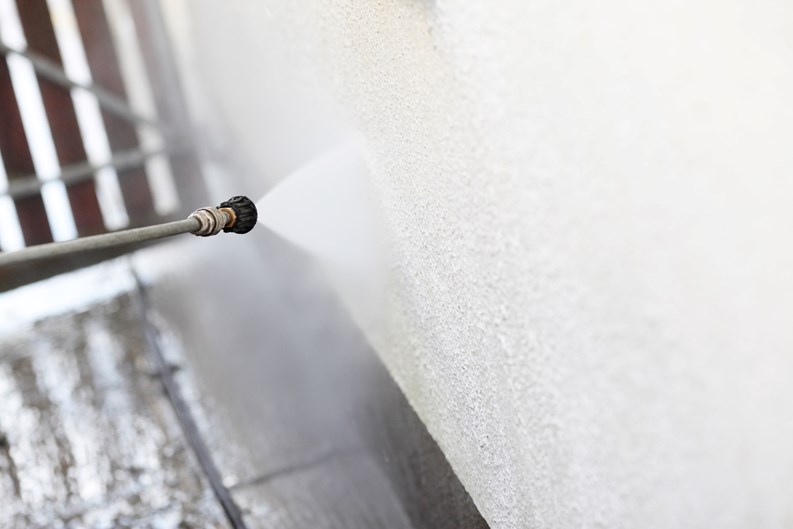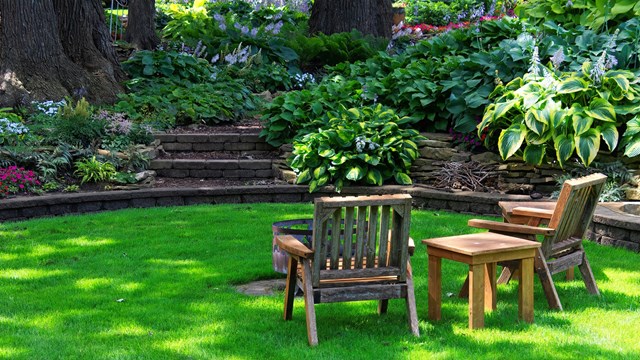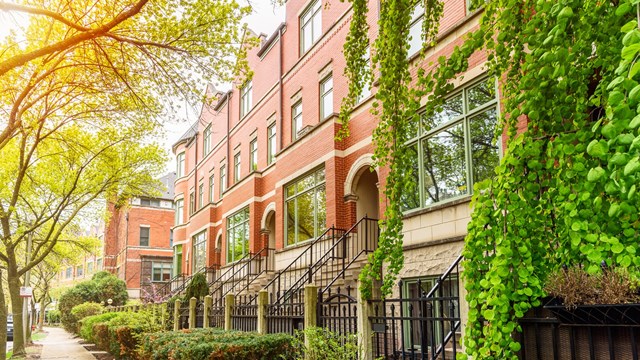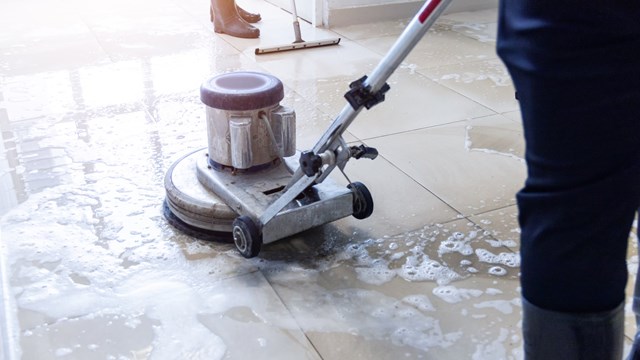Cities and suburbs can be dirty places – and unfortunately, getting that dirt off the façade of a building takes more than just a scrub-brush and a bottle of Mr. Clean. How a building is cleaned depends on two factors: what materials the building is made of, and the nature of the grime accumulated on it. There really is no one product that can clean every building.
Know Your Grime
In bustling cities like Chicago and New York, roads are jam-packed with cars and trucks spewing exhaust into the air 24/7. This exhaust often sticks to the exteriors of buildings, and is a common cause of discoloration, staining, and general dinginess. But not every grimy spot you see on a building comes from exhaust.
“No two stains or sources of grime are necessarily the same,” says Aubrey C. Phillibert of property management company FirstService Residential in New York City. “And what one may call a stain another may call efflorescence, or even algae. The white, powdery effect from efflorescence on bricks could be a sign of water damage. Even rust marks can be attributable to oxidizing metal from roof gutters, leader pipes, and even window lintels.”
In most cases, the outside of a building really is dirty because of this environmental pollution. But Mike Landry, a sales representative for Dakota Evans Restoration Inc., in Palatine, Illinois, says that some buildings can repel dirt and air pollution better than others. “Usually, smoother buildings tend to not collect so much dirt, dust, and grime, whereas others that have a brick surface that’s kind of rough, [or] ones that have an exposed, aggregate-type of rough finish tend to collect atmospheric pollution,” he explains. “Sometimes, on a lighter color of building, you can actually see the carbon buildup.”
In New York City, building facades are often made of a different material than the rest of the building. They are meant to withstand a lot, but even the toughest materials aren’t entirely impervious to the elements. Brick buildings are built to absorb a certain amount of water, and then dry out and release that accumulated moisture. Unfortunately, says Landry, some brick buildings were actually made with cheaper alternatives – and that can cause problems in the long run.
“They couldn’t make the brick fast enough during the building boom [of the early 2000s], so they had to cut some corners,” he explains. “Builders were using recycled product, so some of the buildings that were built in the 2000s do not have brick as resilient as the original was, and it tends to take on more water. As a result, moisture tends to sit in the brick, and that dark discoloration on the outside of the building is caused by it not having a chance to dry out.”
Some Whys and Hows
“Buildings get cleaned for two reasons,” says Doug Weinstein, Vice President of Project Management Group, Inc., which has offices in New York and Florida. “One is because of graffiti or an incident that happens where there was vandalism of some sort that [needs to be] taken care of immediately. The other reason is just to make the building look better.”
Maintaining appearances is an important reason for keeping your building’s exterior clean, but it’s definitely not the only one. Dirt and grime on a building doesn’t cause outright damage to the structure right away, but it can have a corrosive effect if it goes unaddressed for too long. And the longer dirt and other materials are allowed to stay in place, the harder (and more expensive) they are to remove.
“If dirt is neglected, it penetrates through the outside layer of the building, where it would be extremely difficult to clean,” says Landry. “You then spend so much effort cleaning it that you can weaken the resilience of whatever product it is.”
Aside from it being an obvious eyesore, allowing dirt and grime to accumulate on your building’s facade can also affect your bottom line. “The outward appearance may negatively impact resale prices and rental rates if the building appears overly grimy and dirty,” says Phillibert.
How a building is cleaned depends on several factors: the building’s façade, materials, age, cost, and ease of access to clean.
“Suspended scaffolds are used to access the building’s exterior and common tools are used like water, soap, and a bucket – with squeegees for window cleaning,” says Phillibert. “A cleaning product with elevated levels of ammonia may be corrosive to certain building materials but okay for others. To clean brick, stone or stucco facades, power washers with detergents are often used. Some glass curtain wall buildings even have robotic means to keep the facade glistening.”
Dakota Evans Restoration uses a masonry cleaning product called Sure Klean that, Landry says, is formulated to remove the stain without damaging the material. “Other materials, such as aluminum or something other than brick, stone, or concrete, require sensitive products that’s usually done by hand, with a soft cloth, a little bit of low-pressure water.”
Some buildings require two passes of a pressure washer to get all the gunk and grime off, but it must be done very carefully, especially when working with brick. “If someone goes overboard, they can ‘burn’ the bricks,” says Landry. “Next thing you know, you broke down the building’s outside skin – and once you lose that, the building starts to lose its performance. For example, efflorescence in brick is extremely difficult to clean and achieve superior results, because it will always tend to come back.”
Choosing the Right Approach
The company your board or management hires to clean your building should evaluate the exterior and come up with the appropriate cleaning approach. “A lot of times buildings are pressure washed and that could involve just water, or a chemical additive, depending again on what kind of substrate you’re cleaning,” says Landry, “whether it be limestone, cast stone, marble, or brick. Older, prewar buildings need extra caution so that the mortar in between the bricks isn’t damaged.”
Other considerations are ‘green laws’ that may mandate particular treatment and disposal of chemical-containing water or other materials, and whether a building has been declared a landmark. In both Chicago and New York, landmarking commissions must review any work to façades before it is done, which can add more time to the process. They must approve both the method used and any chemicals or detergents to be employed, as well as a consideration as to whether and how the façade cleaning will affect the overall look of the building from a landmark perspective.
If a building’s entire façade needs cleaning, Weinstein suggests that managers and/or boards request that the cleaning contractor do a small sample section before entering into a contract to clean the whole building. “You want to look at how it’s going to come out after it’s cleaned,” he says. “Sample different elements in the building where you have standard brick, and where you may have limestone. They are going to all clean up differently.”
Preventative Maintenance
While it’s best to hire experienced pros to handle anything beyond basic everyday upkeep, your building or HOA staff can be proactive when it comes to monitoring the façade for evidence of staining or grubby build-up. “They can conduct regular exterior inspections and report issues to building management,” says Phillibert. “Power washing sidewalks, buildings’ marquees, and the lower portion of the façade can be performed on a scheduled basis, and will aid in the upkeep of the exterior.”
Beyond that, “a building seldom sets a cleaning schedule,” Phillibert continues. “Brick and stucco facades are cleaned much less frequently, if at all. Windows are generally cleaned on annual basis.”
The cost of an exterior cleaning depends on several factors as well, but scale and logistics are the primary ones – even above the actual level of grime to be scrubbed off. The big question, says Landry, is, “Are we able to access the exterior of the building? A six-story building is much different than a 30-story building.” Other exterior elements can complicate the job too. “Do we have to protect windows or canopies?” Landry continues. “Power washing also must be done on an OSHA-approved surface, so there needs to be a boom lift. Then we figure out approximately how much time it would take for our crew to complete the project.”
Keeping the outside of your building clean is just as important as maintaining your interior spaces, because as the old saw goes, you only get one chance to make a first impression.
Lisa Iannucci is a freelance writer, author, and editor, and a longtime contributor to The Chicagoland Cooperator.










Leave a Comment